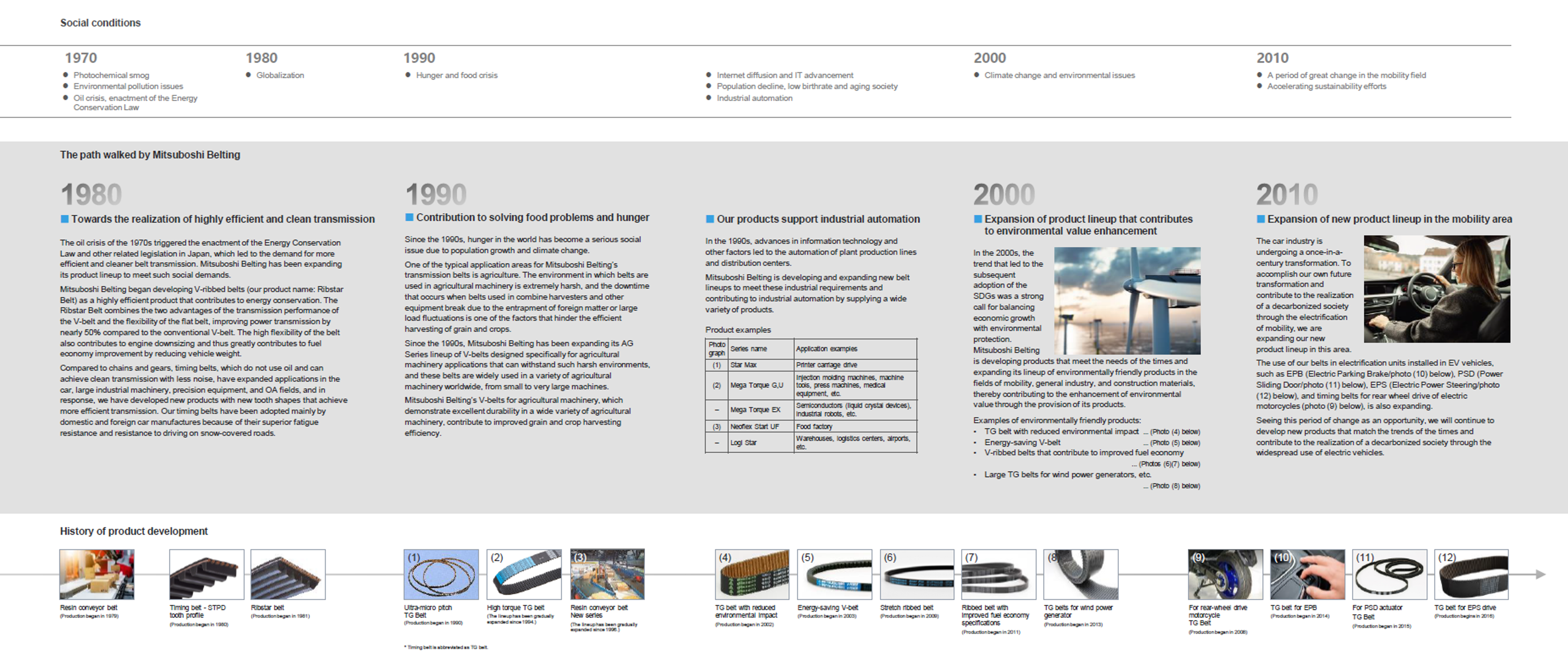Value Creation Process
Since its establishment in 1919, the Mitsuboshi Belting Group has built its unique strengths by sincerely addressing each and every one of its customer’s needs and society’s issues.
By executing a growth strategy that leverages our three strengths - our technological capabilities that we have refined, our manufacturing capabilities that ensure product quality and a stable supply, and our co-creation business model - we will work to create further social value and sustainably enhance our corporate value to realize our “Corporate Vision.”
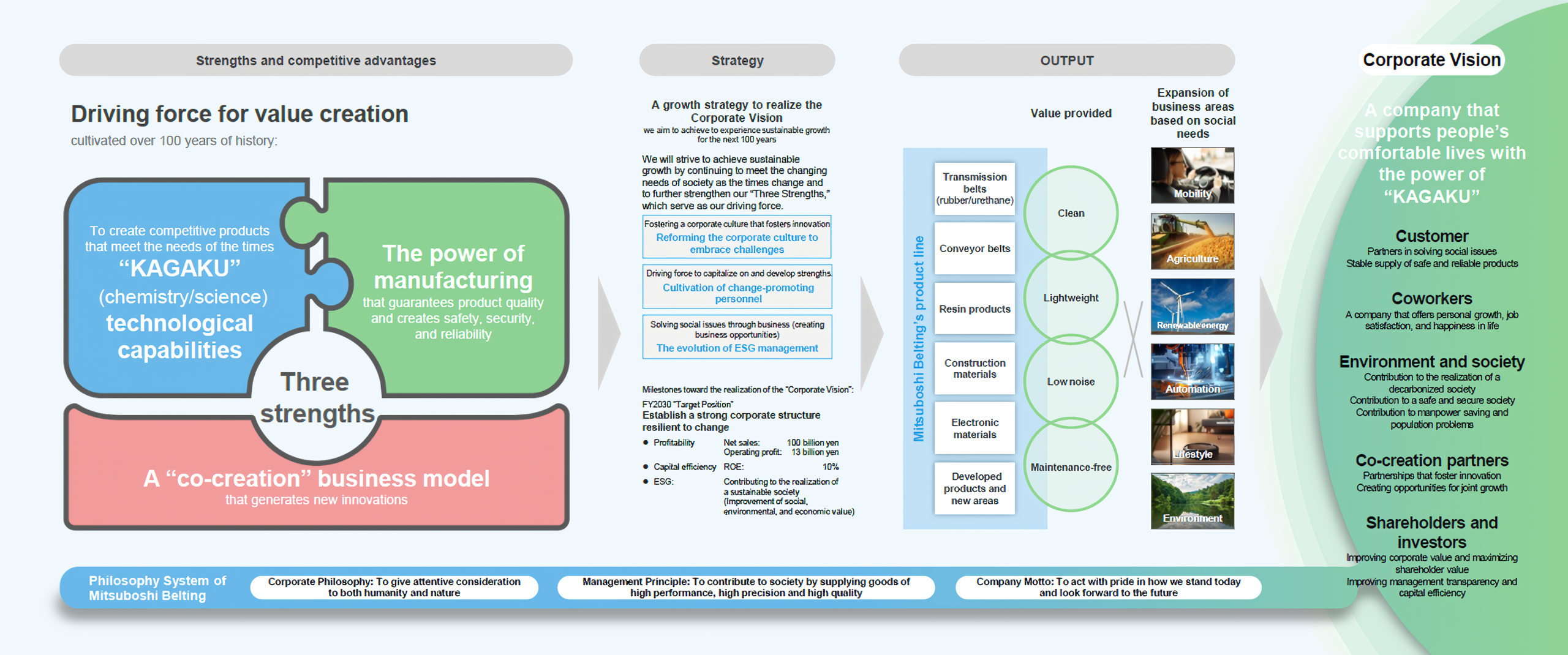
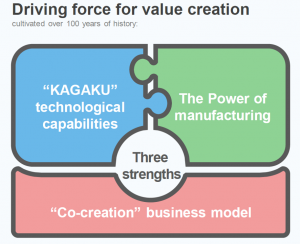
Three Strengths We Have Cultivated
Three Strengths We Have Cultivated
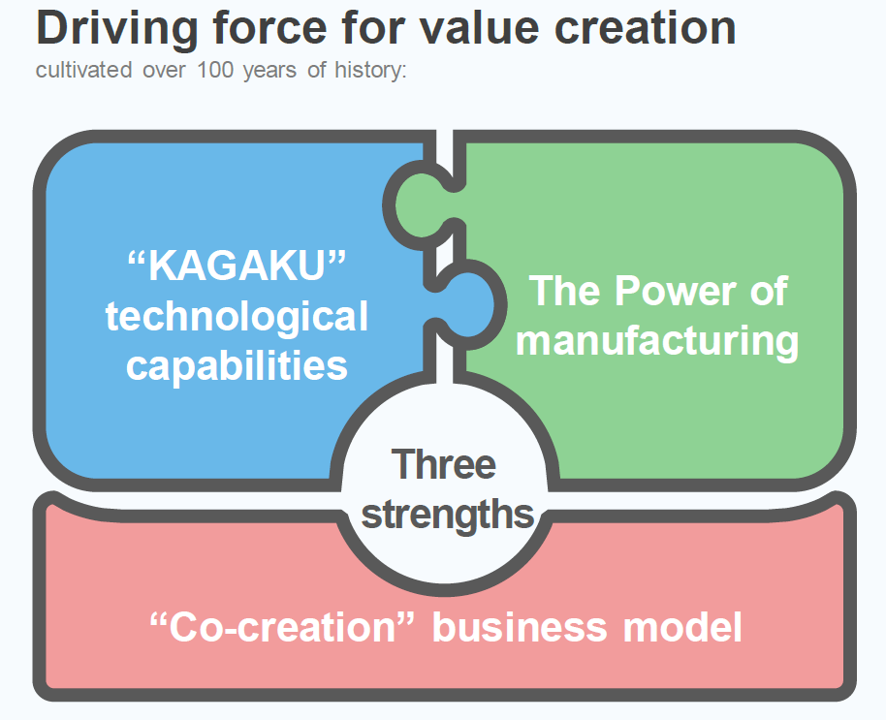
The strengths of the Mitsuboshi Belting Group have been handed down through more than 100 years of accumulated experience and technology.
We are committed to taking on new challenges for the next 100 years, with our three strengths as the driving force for value creation.
To create competitive products that meet the needs of the times
“KAGAKU” technological capabilities
The power of manufacturing
to create safety, security, and trust
A “co-creation” business model
that generates new innovations
Founding Spirit and Philosophy System
Our corporate culture of quality-first DNA and social cohesion, which has been passed down since the company’s founding
|
In 1919, Mitsuboshi Shokai was founded by Genzo Oda, Shinjiro Nakamura, and Kusukichi Kojima. Since then, our company, which began with the production of cotton belts, has expanded its product line and business domain in response to the social issues and conditions of the times and has contributed to the development of society through both “conveyance” and “transportation.” The spirit of quality first and the corporate culture of coexistence and collaboration with society are still deeply rooted in the Mitsuboshi Belting Group. |
Philosophy System of Mitsuboshi Belting 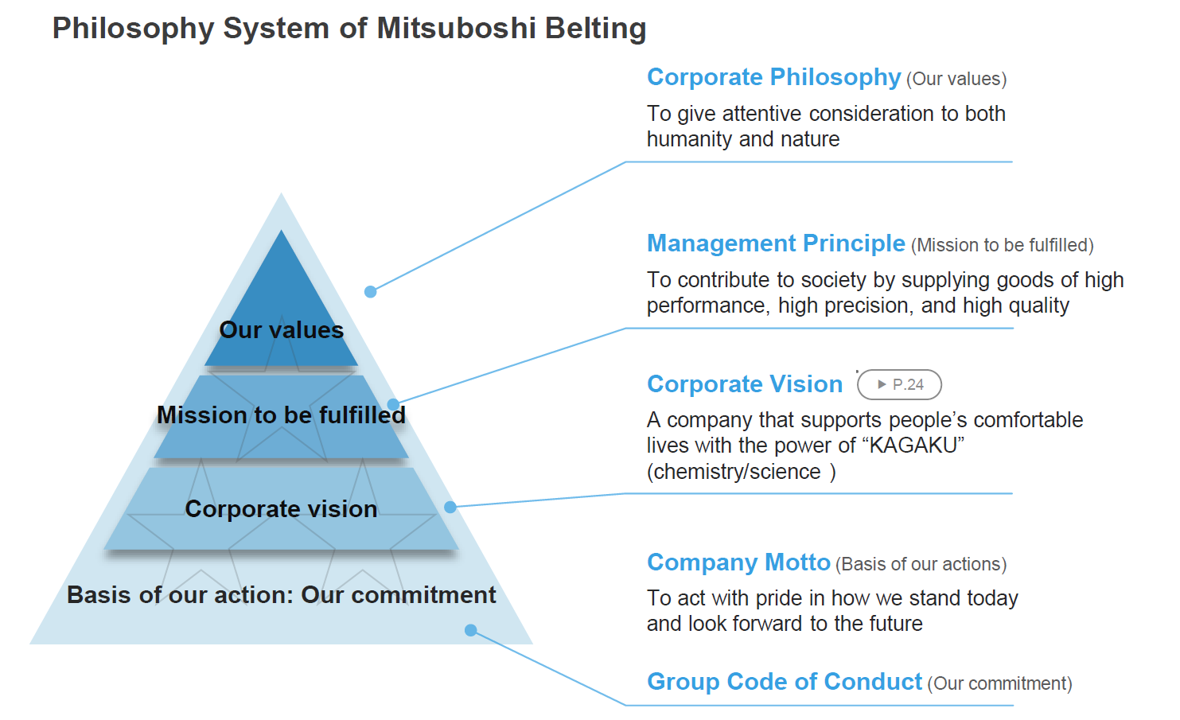
The full text of the Group Code of Conduct is available on our corporate website. |
|---|
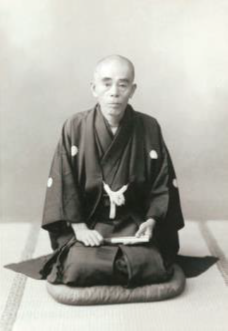 Founder Genzo Oda
Founder Genzo OdaFounding spirit in 1919
- To make products with sincerity.
In 1919, Mitsuboshi Belting (company name at the time of its founding: Mitsuboshi Shokai) began its history as a cotton belt manufacturer. During this period of Japan’s industrial boom, Mitsuboshi Shokai contributed to the development of modern industries such as steel, industrial machinery, and nonferrous metals through power transmission by belts.
The corporate philosophy of the company at the time of its founding was “To make products with sincerity” and “To walk steadily, step by step.” This is where Mitsuboshi Belting’s DNA, which continues to this day, began. For more than 100 years since our founding, we have been honestly committed to “manufacturing quality and selling quality.”
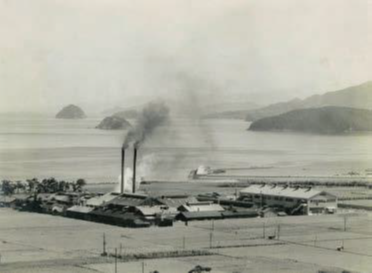 The Shikoku Plant upon completion (1947)
The Shikoku Plant upon completion (1947)Quality-first DNA
“Considering the 100-year life of the business, no compromise is allowed. We will firmly adopt a quality-first policy.”
In 1945, after the end of World War II, Japan’s infrastructure was devastated by the war and society was in dire straits. Mitsuboshi Belting (then known as Mitsuboshi Chotai), which decided to resume production, said: “With supplies extremely depleted, customers will jump at the chance to buy our products, even if the quality is a little lower. Is it better to start mass production for such people and try to make a profit? Or, should we maintain our traditions and focus on quality? Considering the 100-year life of the business, no compromise is allowed. We will firmly adopt a quality-first policy.”
Even in times of turmoil, the spirit of valuing quality was preserved, and Mitsuboshi Belting’s business continues to this day.
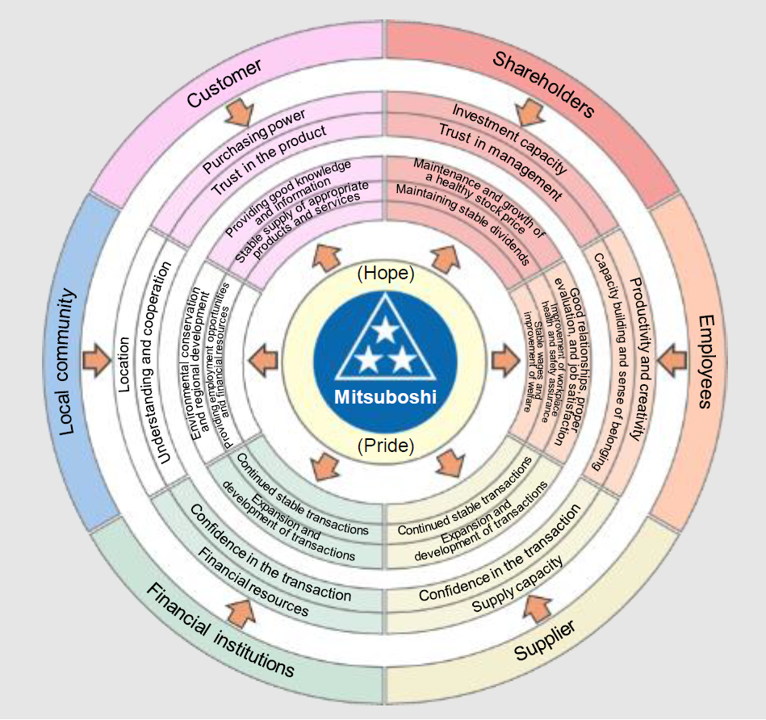 Diagram of the corporate philosophy in 1965
Diagram of the corporate philosophy in 1965A corporate culture that advances hand in hand with society
“All stakeholders involved, with Mitsuboshi at the core, act with pride in Mitsuboshi today and with faith in the hope for Mitsuboshi tomorrow.”
In 1965, Mitsuboshi Belting took the 45th anniversary of its founding as a turning point to review its corporate philosophy, and the above philosophy was established.
Mitsuboshi Belting considers its shareholders, customers, financial institutions, suppliers, employees, and local communities as “all stakeholders” in its business and seeks to improve economic and social value through collaboration with them. Mitsuboshi Belting has been engaged in such business management since the 1960s.
This corporate philosophy from 1965, which has since been partially revised to become our current company motto, has long been passed down as the backbone of Mitsuboshi Belting’s sustainable development, which aims for harmonious business operations.
What is Mitsuboshi Belting’s “Corporate Vision?”
A company that supports people’s comfortable lives with the power of “KAGAKU”
Although you may not often see our products directly, Mitsuboshi Belting products are used in a wide variety of machines and equipment, including cars, motorcycles, office equipment such as printers, ATMs, cash registers, and various home appliances such as washing machines and coffee makers.
Our products may be small, but no machine or piece of equipment can function without our belts. “Every one of Mitsuboshi Belting’s products supports people’s lives.” It is with this spirit that we approach manufacturing.

History of Mitsuboshi Belting
~ The birth of Mitsuboshi Belting and the beginning of its co-creation business ~
Since our founding in 1919, we have developed through a management policy that emphasizes quality-oriented manufacturing and partnerships with distributors.
We have expanded our business domain and product lineup over time. The high quality of our products was recognized in both domestic and international markets, and we established ourselves as a leading company in the industry.
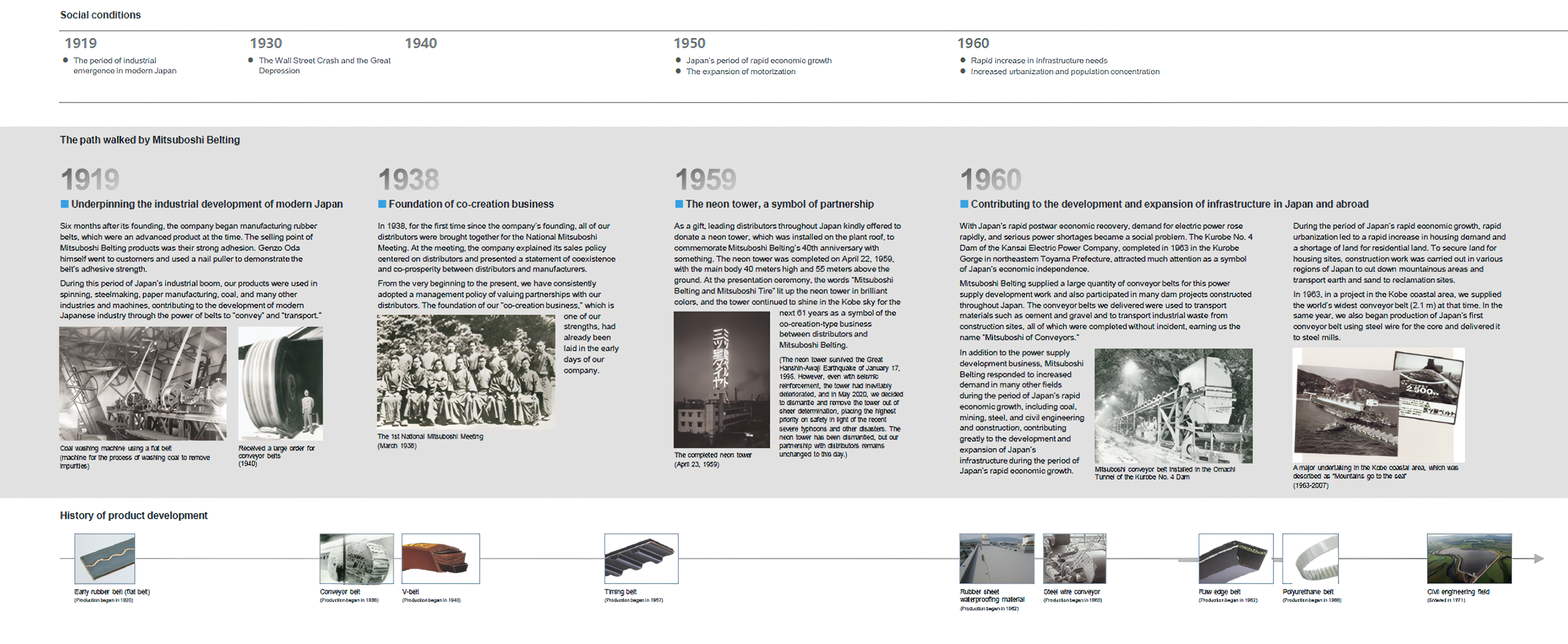
~ Building a global system ~
As Japan entered a period of rapid economic growth, the Mitsuboshi Belting Group also expanded its business both domestically and internationally through technological innovation, improved production capacity, and expansion into global markets. With a continuous focus on quality, Mitsuboshi Belting’s products captured demand in the car and industrial machinery fields, further solidifying the Group’s position.
Active investment in new technologies and research and development led to diversification of the product lineup, efficiency improvement, and higher quality, as well as development of products with reduced environmental impact in light of social issues.
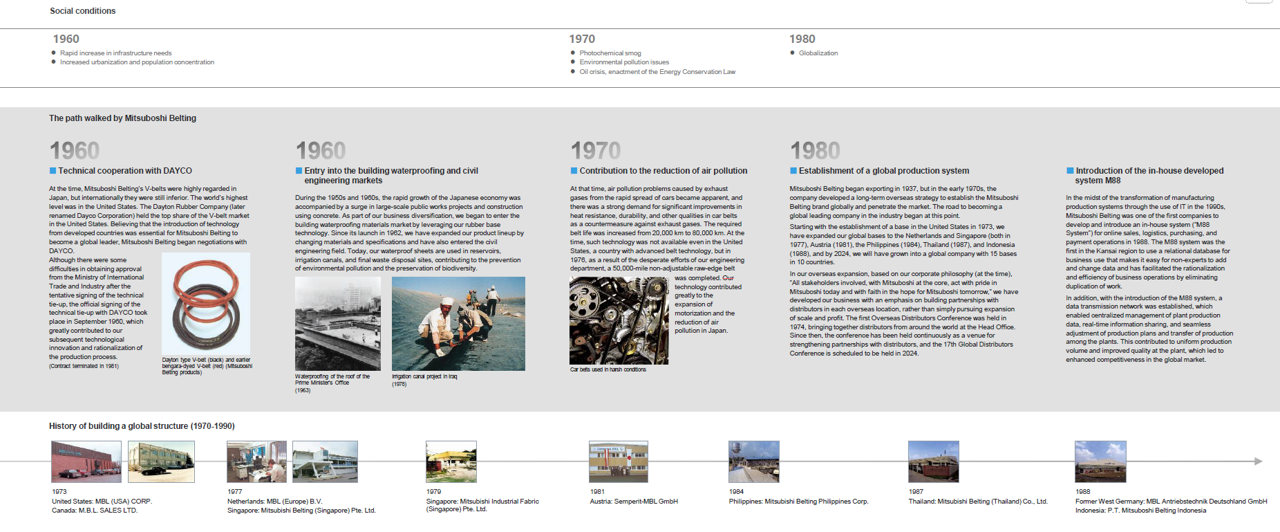
~ To “establish a strong corporate structure resilient to change” and “become a company that supports people’s comfortable lives through the power of ‘KAGAKU’ (chemistry/science)” ~
As globalization and digitalization progress and environmental considerations become prerequisites for business, the Mitsuboshi Belting Group is actively working to strengthen its international competitiveness, improve the functionality and energy efficiency of its products, and expand into new markets.
The Mitsuboshi Belting Group will also continue to develop a variety of initiatives to respond to changing social issues and needs, such as the development of environmentally friendly products for the realization of a sustainable society and the improvement of production processes through the use of IT technology.
